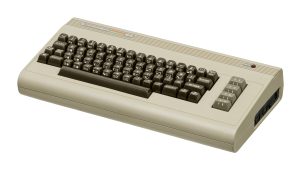The Commodore 64 (an 8bit computer) (known as the C64) is the world’s most sold desktop computer. This is due in part to the low cost of the computer, compared to other computers being sold at it’s release. Not only because of the low cost, but it came with 64k of RAM, included color video graphics due to it’s VIC-II video chip, as well as superior audio from it’s SID chip. Most of the competitor computers at the time had limited or no color and audio. And several that did required purchasing additional hardware to do so. As well, the C64 could either be connected to a Commodore CRT monitor for the best display, or connected to most television units using the RF connection to the included RF switch box. (this provided a lower video display, however it provided a cheap display option for many that could not afford a dedicated CRT monitor).
There are 2 primary models of C64 released. The original C64 “breadbin” Home Computer, and later the C64c “wedge” Personal computer. (there a several revisions of these 2 models, with different versions of system board as well as different keyboards for various language regions)


It’s hardware includes a keyboard unit, with the computer contained inside. It has 64KB of RAM, and 20KB of ROM (which by default is mapped over top of sections of the 64KB of RAM), a MOS 6510 or 8500 cpu running at 1.023 Mhz (on an NTSC machine) or 0.985 Mhz (on a PAL machine). It has a VIC-II (Video Interface Chip) video chip able to display at a resolution of 320×200, 16 colors, as well as hardware sprites. It also has a 6581 or 8580 SID (Sound Interface Device) chip with 3 different voices and able to produce various sounds including digital sound effects.
The computer has a userport (a form of RS-232 serial port), tape/datasette interface, IEC serial bus (normally used to connect to a disk drive or printer device), a DIN Audio/Video connector (for connection to a higher resolution monitor), RF A/V connector (to connect to a television), cartridge/expansion port, power connector, and 2 joystick control ports (supporting atari-style joysticks, mice, paddles, and other input devices).
On it’s own, the C64 does not have any method of permanent storage and unable to save any programs typed in. While a few bundle packs were later released that included a storage device, it was common for most to additionally purchase some form of storage device. Most commercially sold software either was released on cartridge, tape, or 5 1/4 floppy disk.
NOTE FOR NEW or RETURNING C64 owners:
The original C64 power supply bricks were not built with the intention to be used as long as the C64 has lasted. The innards were placed into the brick casing and filled with a resin, which not only helps retain heat but also makes repair a challenging task. It has 2 input voltages (9v AC and 5v DC), and steps down the DC input voltage down to the needed 5v. However it has been very common to find PSU’s that have or suddenly will fail, suddenly allowing the full 10v DC inside your C64 instead of the required 5v. When this happens, the damage is serious and immediate, usually damaging one or more of the custom chips including the SID chip. It is highly advised not to use an original PSU brick and instead obtain a modern C64 PSU which will include protections to prevent the same issue from occurring. There also are C64 Power Saver adapters, which allow you to safely continue to use a working original PSU. With a power saver, when your PSU brick fails, it will shut off the power before it can cause damage. Since this only allows you to use a still functional PSU, it still is suggested to instead replace the PSU instead.
